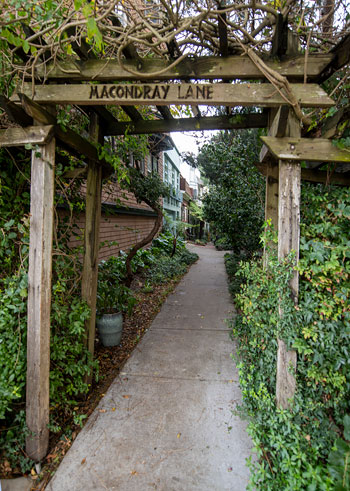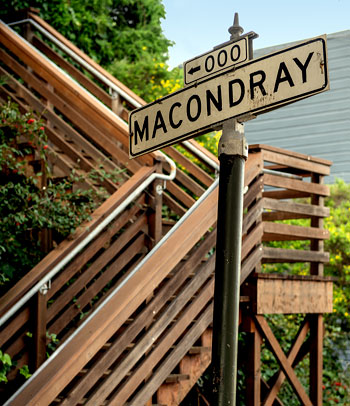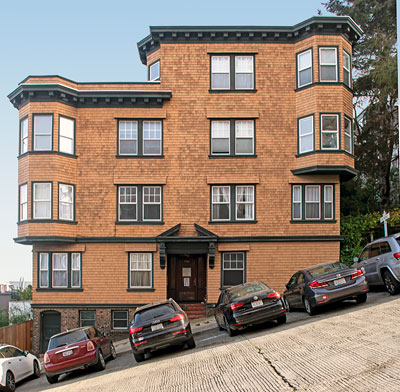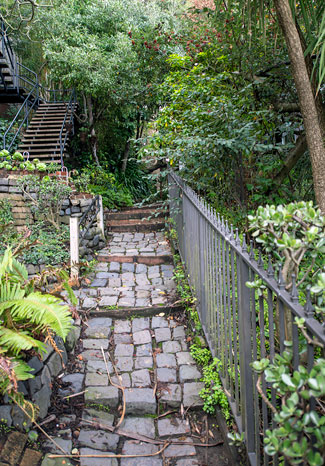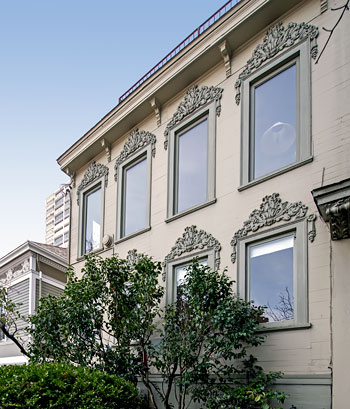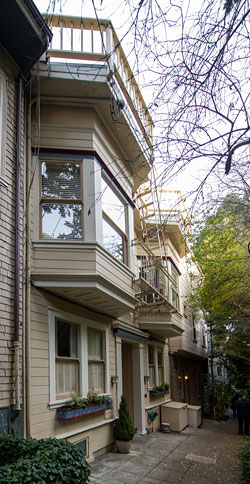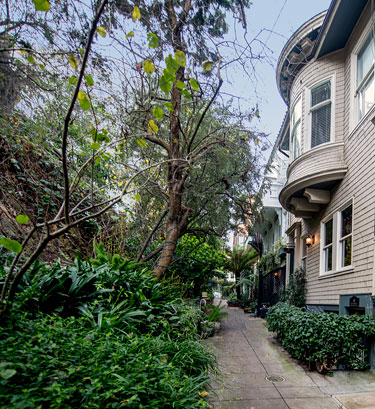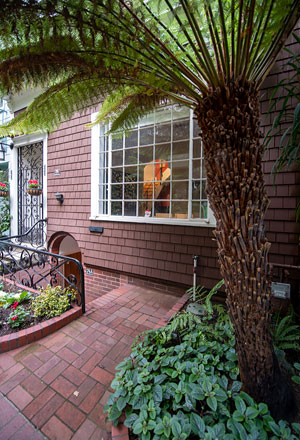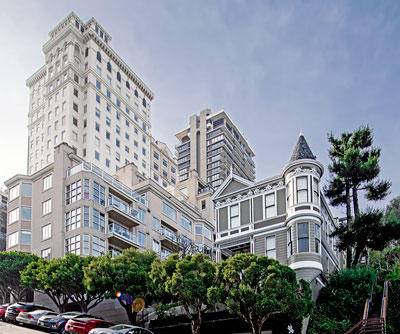National Register of Historic Places in San Francisco
Russian Hill Macondray Lane District
The Macondray Lane District is a picturesque, woodsy village in a lush landscape on a hillside with views of Russian Hill, Telegraph Hill and the San Francisco Bay. The neighborhood was once the home of Italian-Americans, artists and Bohemians. With few exceptions, the dwellings are vernacular.
The oldest surviving house in the district was built in 1878 at 982 Green Street. Most of the original houses in the district were destroyed by the 1906 Earthquake and Fire but were replaced within three years. The last contributing building was built in 1930 at 72 Macondray Lane.
Many residents on Macondray Lane in 1910 bore Italian names such as Devincenzi, Collarino, Arata, Caselli and Martinelli, but no Italians climbed the hill as far as Green Street. Most had middle-class occupations like harness maker, agent, glassworker, stonemason, widow and physician. Their architectural ambitions were modest. Of the fourteen historic buildings only four were designed by architects.
By 1900, some prosperous Italian-Americans, many from Genoa, lived in the district, but none made it as far uphill as Green Street. In the 21st century, the 900 block of Green Street remains an enclave of privilege with three residential highrises at the summit of Russian Hill.
Source: Adapted from the NRHP nomination submitted in 1987.

Macondray Lane was fictionalized as Barbary Lane in Tales of the City by Armistead Maupin.
| Name | Year | Address | Remarks | Sort Address | Sort Name |
|---|---|---|---|---|---|
| Charles Lus Lewis House | 1922 | 940 Green Street | Green 0940 | Charles Lus Lewis House | |
| Augusta Meaburn House | 1907 | 960 Green Street | Green 0960 | Augusta Meaburn House | |
| Edward A. Huber House | 1878 | 982 Green Street | Green 0982 | Edward A. Huber House | |
| Peter Richter Flats | 1908 | 1918-1920 Jones Street | Jones 1918 | Peter Richter Flats | |
| Euphemia Bruns Flats | 1907 | 1950 Jones Street | Jones 1950 | Euphemia Bruns Flats | |
| Euphemia Bruns - William Middleton Cottage | 1907 | 1960 Jones Street | Jones 1960 | Euphemia Bruns - William Middleton Cottage | |
| Macondray Lane | 1859 | Macondray Lane | Macondray 0000 | Macondray Lane | |
| Catherine Maloney - Giuseppe Cadenasso Flats | 1892 | 15-17 Macondray Lane | Macondray 0015 | Catherine Maloney - Giuseppe Cadenasso Flats | |
| Ryer's Apartments | 1908 | 58-66 Macondray Lane | Macondray 0058 | Ryer's Apartments | |
| Charles Bovone House | 1908 | 68 Macondray Lane | Macondray 0068 | Charles Bovone House | |
| Mrs. Genevieve Allen Apartments | 1930 | 72 Macondray Lane | Macondray 0072 | Mrs. Genevieve Allen Apartments | |
| Edward Roland - Anita Whitney Cottage | 1907 | 74 Macondray Lane | Macondray 0074 | Edward Roland - Anita Whitney Cottage | |
| Luigi Demartini House | 1895 | 1809 Taylor Street | Taylor 1809 | Luigi Demartini House |
1950 Jones Street
Built 1907
This natural shingle-clad frame apartment building contributes to the district by style, siting, fenestration, hillside accommodation, materials, age, use and the lack of architect. It steps down the steep hill so that the second floor of the uphill half connects directly with the third floor of the downhill half.
It was constructed by contractor Otto A. Craemer for Euphemia Bruns who lived at 1960 Jones Street. She moved here about 1916.
Since 1859
This right-of-way appears in part on the 1859 U.S. Geological Survey map. About 1912 the name was changed from Lincoln to Macondray for pioneer San Francisco merchant Frederick W. Macondray. The informal landscaping began in the 1920s or earlier.
Macondray Lane is a heavily landscaped, narrow public right-of-way used as a footpath. It descends about sixty feet from Jones Street to Taylor Street. Steep bluffs go up toward the houses on Green Street and down toward those on Union. It begins at Jones Street with a rustic arbor where houses down the Lane are barely visible through the trees. The path is sometimes asphalt, sometimes brick-edged, sometimes cobblestones. The Taylor Street end is a steep boardwalk staircase two flights down.
Everywhere is greenery, from miniature, carefully tended garden plots to wild thickets, from window boxes of geraniums to large eucalyptus, with ferns, azaleas and Japanese maples between.

When we photographed Macondray Lane in December 2019, it appeared unchanged since the above description was submitted in 1987 with the NRHP nomination.
15-17 Macondray Lane
Built 1892
This simple pair of flats is distinguished by Baroque garlands of plaster draped over each opening. These garlands are clearly visible in a photograph taken after the 1906 Earthquake and Fire. The windows, which were originally double-hung, are now single panes of glass.
The second owner was Giuseppe Cadenasso who came to California in 1867 at the age of nine. He rose from being a waiter at Coppa's Restaurant to become a sensitive landscape painter and head of the Mills College art department. Cadenasso lived here from 1905 until 1918 while on the Mills College art faculty.
58-66 Macondray Lane
Built 1908
This miniature apartment building was constructed by developer M. R. Bernheim. The ornamentation is minimal and simple, barely enough to make the building Colonial Revival rather than vernacular.
The occupants in 1910 were a furniture carver, a milliner, a theater musician, a bookkeeper, a jeweler and two electricians. This mixture of workingmen, artisans and artists was common to the district.
68 Macondray Lane
Built 1893
Architect Louis Mastropasqua designed this small set of apartments, which was originally a residence. The design combines Colonial Revival elements (curved bay, modillioned cornice and general plan) and Craftsman elements (natural shingle cladding, the flared bay and the lost window-surrounds).
Mastropasqua, who immigrated from Italy, served an Italian-American clientele. He designed Julius' Castle and the Canessa Building, but he never achieved a wide reputation.
Charles Bovone came to San Francisco with the great migration of 1884. He became secretary of the Oriel Glass Works, which manufactured cut glass and curved glass for bay windows like the one in his house. Around 1928, Bovone retired to Genoa, but his son returned to San Francisco a decade later.
72 Macondray Lane
Built 1930
This small apartment building was constructed by Castle Building Company. The 1910 Census and 1912 Sanborn map indicate a small building at this address, but the 1930 building permit shows an addition costing $2,500, enough to establish the present size and appearance.
74 Macondray Lane
Built 1907
This one-story cottage with a basement was possibly designed by the architectural firm of Carillo & Baker. Natural shingles replaced the original rustic siding in 1912. The wide multi-paned metal sash window probably replaced a narrow double-hung window during fire repairs in 1940.
The Patrician Rebel, Anita Whitney, lived here from 1927 to 1945. Whitney was a suffragette and social worker. During her time in this house, she was a labor organizer and the founder of the Community Party in California.
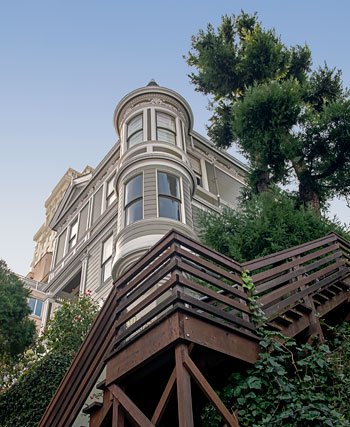
DeMartini House and Macondray Lane Stairs The 19th Century DeMartini House and 20th Century Russian Hill.
The condominiums just up the hill from the DeMartini House were built a few years after the Macondray Lane District was listed on the National Register in 1987. The condominiums replaced two early 20th century, shingled buildings on Green Street. The National Register nomination noted that the two vintage buildings did not contribute to the district because they were "so tragically deteriorated."
The three residential highrises are:
945 Green Street was designed by George A. Bos and Frederick W. Quandt and completed in 1928. It has 14 floors and a height of 53.34 meters.
947 Green Street designed by George A. Bos and Frederick W. Quandt and completed in 1929 It has 10 floors and a height of 36.58 meters.
The Summit was designed by Niell Smith and Associates and completed in 1965. The Summit has 32 floors and a height of 96 meters.
Both Photos 20 December 2019
(Click Photo To Zoom)
1809 Taylor Street
Built 1895
The Luigi DeMartini House is one of four dwellings in the Macondray Lane District to survivor the 1906 Earthquake and Fire.
The Queen Anne house was designed for Luigi DeMartini by the architectural firm William Mooser & Son. DeMartini was one of the few homeowners in the district to hire a prominent architectural firm. His family lived here for seventy years.
DeMartini came to America as an infant in 1856, long before the major Italian immigration of the 1880s. He became a successful confectioners' supplier who helped found the Bank of Italy.
